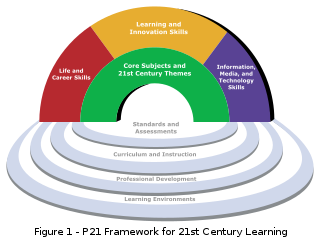Related Research Articles
Emotional intelligence (EI) is defined as the ability to perceive, use, understand, manage, and handle emotions. People with high emotional intelligence can recognize their own emotions and those of others, use emotional information to guide thinking and behavior, discern between different feelings and label them appropriately, and adjust emotions to adapt to environments.

Physical education, often abbreviated to Phys. Ed. or PE, and sometimes informally referred to as gym class or simply just gym, is a subject taught in schools around the world. PE is taught during primary and secondary education and encourages psychomotor, cognitive, and effective learning through physical activity and movement exploration to promote health and physical fitness. When taught correctly and in a positive manner, children and teens can receive a storm of health benefits. These include reduced metabolic disease risk, improved cardiorespiratory fitness, and better mental health. In addition, PE classes can produce positive effects on students' behavior and academic performance. Research has shown that there is a positive correlation between brain development and exercising. Researchers in 2007 found a profound gain in English Arts standardized test scores among students who had 56 hours of physical education in a year, compared to those who had 28 hours of physical education a year.

Mentorship is the patronage, influence, guidance, or direction given by a mentor. A mentor is someone who teaches or gives help and advice to a less experienced and often younger person. In an organizational setting, a mentor influences the personal and professional growth of a mentee. Most traditional mentorships involve having senior employees mentor more junior employees, but mentors do not necessarily have to be more senior than the people they mentor. What matters is that mentors have experience that others can learn from.
Media literacy is an expanded conceptualization of literacy that includes the ability to access and analyze media messages as well as create, reflect and take action, using the power of information and communication to make a difference in the world. Media literacy is not restricted to one medium and is understood as a set of competencies that are essential for work, life, and citizenship.
A skill is the learned ability to act with determined results with good execution often within a given amount of time, energy, or both. Skills can often be divided into domain-general and domain-specific skills. For example, in the domain of work, some general skills would include time management, teamwork and leadership, self-motivation and others, whereas domain-specific skills would be used only for a certain job. Skill usually requires certain environmental stimuli and situations to assess the level of skill being shown and used.
Ayman Sawaf is a social commentator, film producer, entrepreneur, musician and author.
Soft skills, also known as power skills, common skills, essential skills, or core skills, are psychosocial skills generally applicable to all professions. These include critical thinking, problem solving, public speaking, professional writing, teamwork, digital literacy, leadership, professional attitude, work ethic, career management and intercultural fluency. This is in contrast to hard skills, which are specific to individual professions.
Competence is the set of demonstrable characteristics and skills that enable and improve the efficiency or performance of a job. Competency is a series of knowledge, abilities, skills, experiences and behaviors, which leads to effective performance in an individual's activities. Competency is measurable and can be developed through training.

Digital literacy is an individual's ability to find, evaluate, and communicate information using typing or digital media platforms. It is a combination of both technical and cognitive abilities in using information and communication technologies to create, evaluate, and share information.
Workplace wellness, also known as corporate wellbeing outside the United States, is a broad term used to describe activities, programs, and/or organizational policies designed to support healthy behavior in the workplace. This often involves health education, medical screenings, weight management programs, and onsite fitness programs or facilities. It can also include flex-time for exercise, providing onsite kitchen and eating areas, offering healthy food options in vending machines, holding "walk and talk" meetings, and offering financial and other incentives for participation.
The emotional thought method develops a group of activities that can be used in a personal or group-oriented way. This method concerns developing emotional intelligence in a similar way that Daniel Goleman (1995) proposed in his book Emotional Intelligence, a bestseller book written in 1995.
Job performance assesses whether a person performs a job well. Job performance, studied academically as part of industrial and organizational psychology, also forms a part of human resources management. Performance is an important criterion for organizational outcomes and success. John P. Campbell describes job performance as an individual-level variable, or something a single person does. This differentiates it from more encompassing constructs such as organizational performance or national performance, which are higher-level variables.
Life skills are abilities for adaptive and positive behavior that enable humans to deal effectively with the demands and challenges of life. This concept is also termed as psychosocial competency. The subject varies greatly depending on social norms and community expectations but skills that function for well-being and aid individuals to develop into active and productive members of their communities are considered as life skills.
People skills are patterns of behavior and behavioral interactions. Among people, it is an umbrella term for skills under three related set of abilities: personal effectiveness, interaction skills, and intercession skills. This is an area of exploration about how a person behaves and how they are perceived irrespective of their thinking and feeling. It is further elaborated as dynamics between personal ecology and its function with other people's personality styles in numerous environments. British dictionary definition is "the ability to communicate effectively with people in a friendly way, especially in business" or personal effectiveness skills. In business it is a connection among people in a humane level to achieve productivity.
The term emotional literacy has often been used in parallel to, and sometimes interchangeably with, the term emotional intelligence. However, there are important differences between the two. Emotional literacy was noted as part of a project advocating humanistic education in the early 1970s.

Joshua Freedman is a specialist on emotional intelligence, an author, and the Chief Executive Officer of Six Seconds, a non-profit dedicated to emotional intelligence (EQ). He has helped co-develop EQ assessments and published a number of books and articles on the topic, creating an international network of consultants and coaches.
Bullying is abusive social interaction between peers and can include aggression, harassment, and violence. Bullying is typically repetitive and enacted by those who are in a position of power over the victim. A growing body of research illustrates a significant relationship between bullying and emotional intelligence.
Judith E. Glaser was an American author, academic, business executive, and organizational anthropologist. She was the founder and chief executive officer of Benchmark Communications, Inc., an executive coaching and management consulting company based in New York City and Boston. Glaser was also the co-founder and chairman of the Creating WE Institute. During her career, she worked with clients including Clairol, Citibank, Pfizer, Burberry, American Airlines, and Verizon.

21st century skills comprise skills, abilities, and learning dispositions identified as requirements for success in 21st century society and workplaces by educators, business leaders, academics, and governmental agencies. This is part of an international movement focusing on the skills required for students to prepare for workplace success in a rapidly changing, digital society. Many of these skills are associated with deeper learning, which is based on mastering skills such as analytic reasoning, complex problem solving, and teamwork, which differ from traditional academic skills as these are not content knowledge-based.
Isolation is often used to facilitate power and control over someone for an abusive purpose. This applies in many contexts such as workplace bullying, elder abuse, domestic abuse, child abuse, and cults.
References
- 1 2 3 4 5 Williams, Rachel K. (2007-01-01). Emotional Intelligence and Leadership Style: An Investigation Within a Major Telecommunications Company. Capella University. ISBN 9780549319085.
- ↑ A. Kerr, Barbara (2009). "Connecting Emotional Intelligence to Success in the Workplace" (PDF). HRDQ.
{{cite journal}}: Cite journal requires|journal=(help) - ↑ Kewalramani, Soni; Agrawal, Manju; Rastogi, Mukta Rani (2015-08-10). "Models of emotional intelligence: Similarities and discrepancies". Indian Journal of Positive Psychology. 6 (2). ISSN 2229-4937.
- 1 2 3 4 5 "Emotional Intelligence and Burnout among Teachers in a Rural Florida School District". ufdc.ufl.edu. Retrieved 2015-09-23.
- 1 2 3 4 Cooper, Robert K.; Sawaf, Ayman (1998-01-01). Executive EQ: Emotional Intelligence in Leadership and Organizations. Penguin. ISBN 9780399524042.
- ↑ Venkoba Narayanappa. "A Study of General Teaching Competency of Women Student Teachers in Relation to their Interest in Teaching, Emotional Intelligence, Adjustment and Personality" (PDF). Karnataka State women University, Bijapur. Archived from the original (PDF) on 4 March 2016. Retrieved 23 September 2015.
{{cite journal}}: Cite journal requires|journal=(help) - 1 2 Geetika, Kaushal; Jigisha, Dholakia (May 2001). "Emotional Intelligence at the Workplace: A preliminary study of male executives in the Public and Private sector organisations".
{{cite journal}}: Cite journal requires|journal=(help) - ↑ MARIA VERMEULEN, ELIZABETH (August 2001). "EMOTIONAL INTELLIGENCE AS DETERMINANTOF THE IDEAL CHARACTERISTICS TO DELIVER THE BEST SERVICE TO CUSTOMERS" (PDF). UNIVERSITY OF WALES. Archived from the original (PDF) on 2016-03-10.
{{cite journal}}: Cite journal requires|journal=(help) - ↑ "Pre-Doctoral Graduate Personal Emotional Intelligence Assessment - Sumo Nova". sumonova.com. Retrieved 2015-09-23.
- ↑ Aneesh Kurian (2013). "Adolescents And Emotional Intelligence: A Critical Analysis" (PDF). Aarhat Multidisciplinary International Education Research Journal. 2 (5). ISSN 2278-5655 . Retrieved 23 September 2015.

